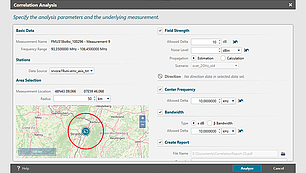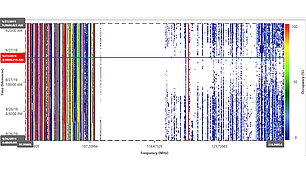Bridging Spectrum Monitoring & Management for Smarter Decision-Making
Effective spectrum management requires real-world insights into spectrum usage. By integrating spectrum monitoring with spectrum management systems, regulatory authorities and operators can ensure compliance, detect interference, and optimize frequency allocation.
LS telcom’s combined system solutions provide seamless integration between spectrum monitoring (LS OBSERVER) and spectrum management (mySPECTRA). This allows users to automate compliance checks, detect license violations, and compare real-world spectrum data against licensed allocations.
With the correlation feature, our system compares entries from the transmitter database with recorded measurement data across various parameters and generates detailed reports. With Automatic Violation Detection (AVD), our system generates spectrum masks from licensed emitter databases, continuously analyzing real-time monitoring data to identify discrepancies. Using wave propagation modeling and topographic data, the system predicts expected signal levels and automatically flags inconsistencies - enabling 24/7 automated enforcement and interference resolution.
By bridging spectrum monitoring and management, LS telcom empowers organizations to make informed, data-driven decisions and ensure efficient spectrum usage.
Seamless Integration for Real-Time Spectrum Insights
Automate spectrum compliance, detect violations, and enhance operational efficiency with our combined system solutions.

Correlation
The correlation feature enables analysis by comparing entries from the transmitter database with real-world measurement data. It evaluates key parameters such as direction, center frequency, bandwidth and field strength (using built-in wave propagation calculations to estimate expected levels at the monitoring unit). Each correlation parameter can have an individually defined "allowed delta", giving users precise control over acceptable deviations. Results are presented in a comprehensive table and can be exported as a detailed report.

Automatic Violation Detection (AVD)
The Automatic Violation Detection (AVD) feature operates 24/7, automatically triggering alerts when anomalies such as interference or non-compliant emissions are detected. AVD utilizes reference levels calculated through wave propagation modeling, using the licensed transmitter database as input. This enables continuous monitoring of compliance with license conditions.

Channel analysis and overlay
The channel analysis and overlay features use frequency plan data from spectrum management to support channel-based analysis, such as channel power measurements, multi-channel direction finding (DF), and frequency channel occupancy (FCO) analysis. Channel data can also be overlaid on measurement charts, providing users with clear guidance on which bands and channels correspond to the signals currently observed in the measurements.

Statistical spectrum usage data
Long-term recorded measurement data is processed to provide spectrum managers with meaningful insights into channel and spectrum usage. The primary data type in this context is frequency channel occupancy (FCO) data. This information can be used to support new frequency assignments or reassignments.